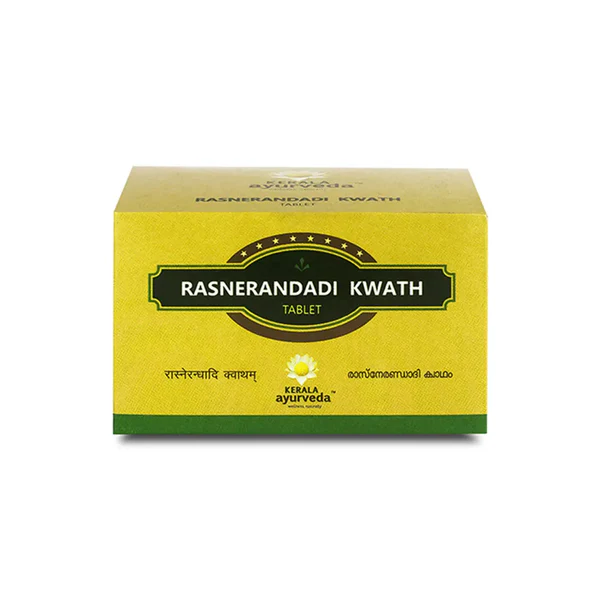
Product Details
Kerala Ayurveda Rasnerandadi Kwath - For rheumatoid arthritis treatment in Ayurveda
Rasnerandadi Kwath is a poly-herbal Ayurvedic formulation containing key ingredients that are known to be used in the preparation of ayurvedic rheumatoid arthritis medicine and arthritis medication. Specific Ayurvedic kashayams are widely known to be useful in the treatment of inflammation, pain, gout, backache, pain due to injury and similar discomforts.
Kerala Ayurveda Rasnerandadi Kwath Ingredients:
Kerala Ayurveda’s Rasnerandadi Kwath is prepared using the below key ingredients:
-
Rasna - Alpinia galanga
Rasna plant is used in many Ayurvedic medicines to help with inflammation, bronchitis, asthma, cough, indigestion, piles, joint pain, obesity, and diabetes. The paste of the leaf is also applied externally to reduce swelling.
-
Eranda - Ricinus communis
Castor plant has anti-oxidant, anti-inflammatory, antimicrobial, the liver-protecting and various other medicinal properties. Castor oil or eranda taila is a very good laxative, anti-inflammatory and cures skin problems.
-
Shunti - Based on principles of Ayurveda, shunti or ginger normalises Kapha and Vata and so this herb is used in diseases in which Kapha and vata doshas are prominent.
-
Giloy - Tinospora cordifolia - According to Ayurveda, guduchi or Giloy has the ability to flush the excess ama or toxins from the body. It also helps boost digestion and remove waste products from the body.
Other ingredients used:
-
Sahachara - Barleria prionitis
-
Shatavari - Asparagus racemosus
-
Dusparsa -Tragia involucrata
-
Vasa - Justicia beddomei
-
Deodar - Cedrus deodara
-
Mushta - Cyperus rotundens
-
Kshuraka - Hygrophila schulli
An Ayurvedic perspective to Arthritis
According to Ayurveda mostly pains are caused by the aggravation of vata dosha. Arthritis is a condition that is caused by the accumulation of ama (a toxic by-product of improper digestion) and aggravation of Vata. Ama circulates in throughout the body and gets deposited at the sites which are weaker. When it deposits in the joints and at the same time there is the aggravation of Vata, it results in a disease called amavata. This amavata is arthritis.
Since arthritis is caused due to vata aggravation, the main aim of Ayurvedic treatment for arthritis is to balance and stabilize vata in the body. This can be done by strengthening the alimentary canal and the metabolic pathway. This ensures that the circulatory channels are not blocked by impurities and are open and performing well, and that nourishment is delivered to joints.
The qualities of Vata, and this particular type of Ama, have a catabolic/drying effect that causes deterioration of the soft tissues in the joints and eventually the bones. At the same time, Ama can block the channels, supplying nutrients to the joints causing further malnutrition. The deterioration and subsequent irritation in the joint causes inflammation, stiffness, swelling and pain.
In Ayurveda, rheumatoid arthritis is seen as a disease of toxic accumulation and immune malfunction. In the case of rheumatoid arthritis, there is a very high level of accumulated Ama and in many cases, a considerable amount of excess heat (or Pitta). This Ama, combined with aggravated Vata and Pitta moves into the channels of the body and begins to affect Ojas. This causes Ojas to become depleted and its qualities are changed. At the same time Ama blocks the channels and prevents the production of Ojas, depleting it further.
This is the basis of an autoimmune-disease. Ojas begins to function incorrectly and, along with Ama, causes the inflammatory responses, swelling and pain that we recognize as rheumatoid arthritis.
Arthritis - An Overview
Arthritis is a disorder that is characterized by inflammation of the joints. This disorder usually develops after the age of 65; however, it does not mean that people from other age groups aren’t at any risk whatsoever Arthritis is a word taken from Greek, and literally means ‘Joint-Inflammation’. This inflammation can affect one or more joints, depending on the type of arthritis and the chronic nature or severity of the condition.
There are many types of arthritis, including:
-
Osteoarthritis: Osteoarthritis is a condition that is characterized by inflammation and stiffness in the joints caused due to injury, age or obesity.
-
Rheumatoid arthritis: Rheumatoid arthritis is a disorder wherein the immune system attacks the healthy tissues and cells of the joint.
-
Ankylosing spondylitis: Ankylosing spondylitis is an inflammatory disease that, over time, can cause some of the small bones in your spine (vertebrae) to fuse.
-
Gout: Gout is a type of arthritis that causes inflammation, usually in one joint, that begins suddenly and is caused by the deposition of needle-like crystals of uric acid in a joint.
-
Psoriatic arthritis: Psoriatic arthritis is a form of arthritis that affects some people who have psoriasis — a condition that features red patches of skin topped with silvery scales
Causes of arthritis:
The cartilage is a flexible connective tissue present in your joints. Its function is to cushion the joints from pressure and shock. Any drop in the amounts of cartilage present leaves one immensely prone to arthritis. While on one hand, osteoarthritis is generally caused by normal wear and tear of the joints, rheumatoid arthritis is caused by the immune system erroneously attacking the healthy cells of the joint.
The most common complaint when it comes to arthritis is pain, swelling and stiffness in the joints. Often pain or stiffness can be mild to begin with causing people to ignore it however when the symptoms get generally worse, then the underlying problem becomes much harder to treat.







